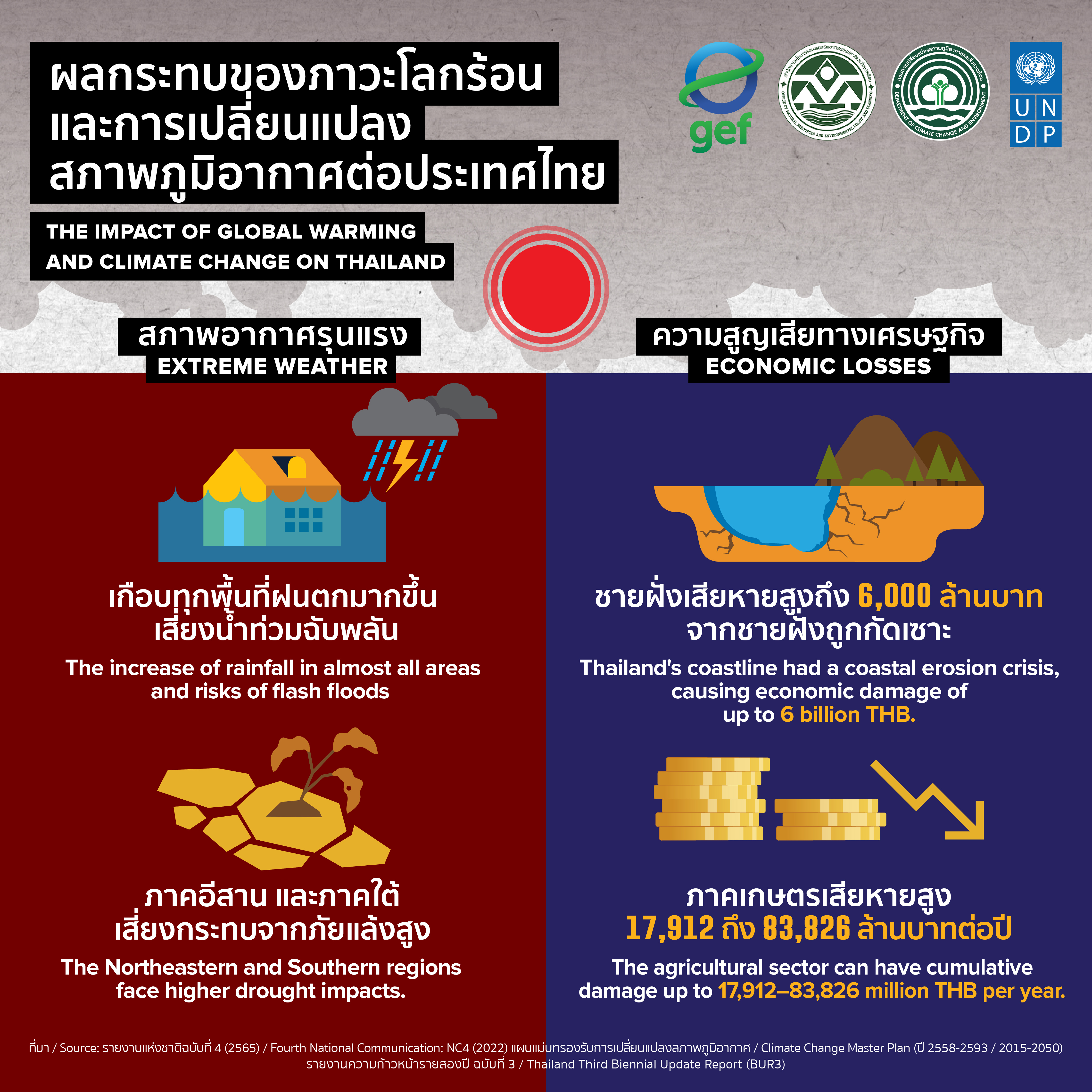Global Boiling and Climate Change: Which sector in Thailand is the largest contributor of greenhouse gas emissions?
April 29, 2024
How do greenhouse gases contribute to climate change? What is their connection to climate change?
Greenhouse gases are generated both naturally and through human activities. Naturally, they arise from processes like respiration and volcanic eruptions. Human activities, however, contribute significantly to their emissions, such as burning fossil fuels like coal, oil, and gas. When fossil fuels are burned, greenhouse gases are emitted, forming a blanket-like layer around the Earth. This layer traps heat from the sun, preventing it from escaping back into space and leading to an increase in temperature. When greenhouse gases accumulate excessively in the atmosphere, the Earth's surface temperature rises, resulting in various natural disasters such as severe droughts, water shortages, wildfires, rising sea levels, flooding, polar ice melting, major hurricanes, loss of biodiversity, and many more. Importantly, the increased temperatures not only affect humans but also impact other life forms on the Earth and its environmental systems.

How much has the Earth's temperature risen since the pre-industrial era?
Human activities have led to a temperature increase of approximately 1.0 degree Celsius compared to pre-industrial levels, and forecasts suggest a potential rise of up to 1.5 degrees Celsius by 2030-2052. This rise is significant as it impacts not only human life, such as coastal communities facing higher sea levels, but also jeopardizes over 1 million species of animals and plants, marking the largest threat towards lives in human history.
Climate change affects the economy significantly, amounting to THB 83,826 million per year.
The accumulation of greenhouse gases not only triggers severe weather events that directly affect human life and the environment but also results in substantial economic losses.
- In terms of climate change, nearly every region in Thailand experiences increased rainfalls each year, resulting in sudden floods and various natural disasters such as frequent flash floods, and the risk of further disasters like tsunamis. Warm and rising sea levels pose a threat to coastal communities, particularly in the northeastern and southern regions, which are more vulnerable to droughts than other areas. The ensuing impacts of climatic conditions also stretch to droughts, nutrient deficiencies, damage to agriculture, fishing, and livestock breeding activities.
- Regarding economic repercussions, over the past few years, 23% of coastal areas have faced erosion crises and land loss at the rates of 1-5 meters per year, resulting in significant economic damages of up to THB 6,000 million annually. Climate change adversely affects agriculture, as the fluctuating temperatures and rainfall patterns lead to less fertile soil for cultivation and insufficient water for farming. This further results in agricultural losses – rotting of crops due to excessive rainfalls and sugarcane suffering from prolonged droughts. Livestock itself is also impacted, aggravating health, growth, and breeding as pigs breed less when they experience stress. Cumulatively, between the years 2011-2035, the impacts on the agricultural sector alone can result in total losses ranging from THB 17,912 to 83,826 million per year.

Did you know which sector in Thailand emits the highest amount of greenhouse gases?
More than 60% of greenhouse gases come from the energy sector, according to Thailand's Greenhouse Gas Inventory* for the year 2018, calculated from five sectors**, the energy sector accounted for 69.06%, agriculture sector 15.69%, industrial processes and product use sector 10.77%, and waste sector 4.88% of greenhouse gas emissions.

The energy sector emits greenhouse gases mainly from electricity and heat production, accounting for 40.05%.

The agriculture sector emits greenhouse gases from agricultural activities, accounting for 77.57%, and from livestock, accounting for 22.43%.

The industrial processes and product use sector emits greenhouse gases mainly from cement production, exceeding half, at 51.28%.

The waste sector emits greenhouse gases from solid waste disposal, accounting for 52.53%.

The warmer the weather, the harder it is to cope.
Climate change affects every region and every individual differently, with some groups bearing heavier burdens than others. The particularly vulnerable are those working in sectors highly sensitive to climate change and lacking adequate coping mechanisms, such as low-income earners, communities in disaster-prone areas, and businesses reliant on weather and natural resources for livelihoods, especially in tourism or small-scale agriculture. Despite contributing only 15.69% of greenhouse gas emissions, small-scale operators and those in the agricultural sector are exceptionally vulnerable to climate change due to their direct dependence on weather conditions.
Climate change impacts each sector and each individual differently, often in unforeseen ways. Even urban dwellers can face risks due to increasing population density and heat from global warming. Climate change is, indeed, a matter for everyone – climate change adaptation thus means justice and equity.

*Thailand has developed a greenhouse gas inventory to record the amount of greenhouse gas emissions and use it as continuous data for analyzing changes and trends in greenhouse gas emissions in the future. It also serves as a national report presented to the United Nations under Thailand's commitment to the United Nations Framework Convention on Climate Change (UNFCCC).
**The Land Use, Land-Use Change and Forestry (LULUCF) sector absorbs more greenhouse gases than it emits, so the emissions from this sector are not included in the proportion of greenhouse gas emissions.
Download NC4 report on national circumstances on climate change

 Locations
Locations



